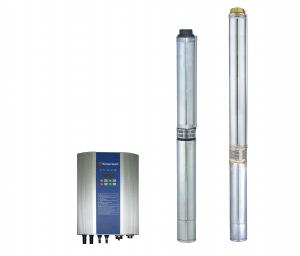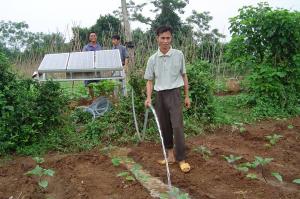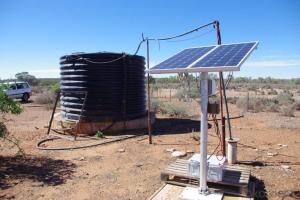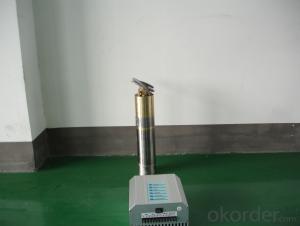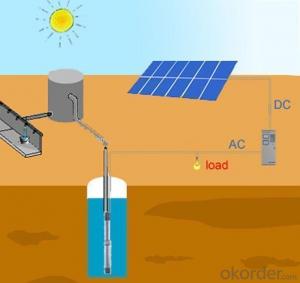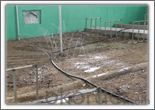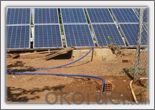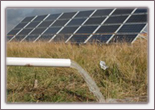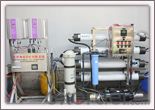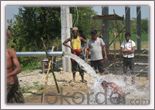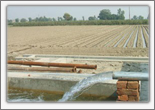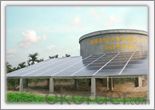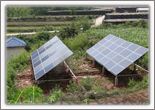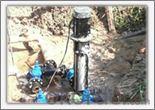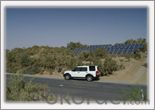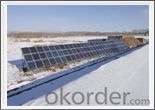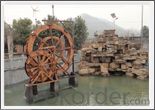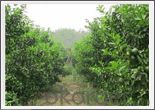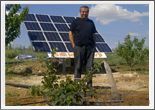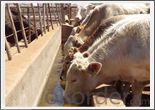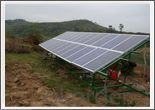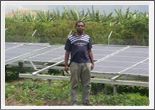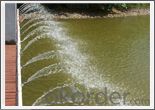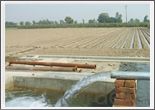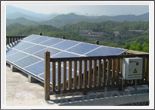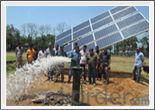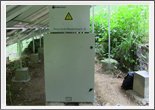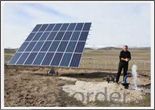Solar Pumping Systems Water for Life Solar Pump
- Loading Port:
- Shekou
- Payment Terms:
- TT OR LC
- Min Order Qty:
- 20 unit
- Supply Capability:
- 800000 unit/month
OKorder Service Pledge
OKorder Financial Service
You Might Also Like
Solar Inverter Introduction:
Solar pumping inverter converts DC current from the solar array into AC current to drive the pump. With the function of MPPT (maximum power point tracking), it regulates the output frequency according to irradiation in real time to achieve the maximum power.
Solar Inverters Features:
1. Adopting the proposed dynamic VI maximum power point tracking (MPPT) control method; Fast response and stable operation; Better than the conventional methods which may lead to the problems including poor tracking performances, unstable or even cause water hammer damaging when the irradiation on the array changes rapidly.
2. The solar pumping inverters system is dispensed with energy storing devices, and stores water instead of electricity. It improves the reliability of the device, at the same time, it lowers the construction and maintenance costs of the system dramatically.
3. Digital control; automatic operation and data acquisition/storage of 8 years, etc; 98% of conversion efficiency, and complete protection.
4. In-line blocks; user friendly; convenient for operating; perfect cooling and shielding.
Solar Pumping Inverter Advantages:
1. To drive pumps equipped with 3-phase induction motors.
2. Optimized SPWM.
3. Various operation modes and MPPT algorithms are available.
4. Adjustable speed range of pump based on the actual situation of the system.
5. Available option of water-level detecting and control circuit.
6. Protection functions: lightning, over/low input voltage, over current and over load protection, etc.
7. Enclosure class: IP52.
8. Ambient temperature:-10~+50˚C.
Specification:
Model | Maximum input dc voltage | Recommended MPP Voltage | Rated Output Current | Output Voltage | Output Frequency | Net Weight | Gross Weight | Package Size | ||
Length | Width | Height | ||||||||
PB5500H | 750 | 500-600 | 13 | 3PH 380V | 0-50 | 7.3 | 9.6 | 425 | 325 | 285 |
PB7500H | 750 | 500-600 | 18 | 3PH 380V | 0-50 | 7.7 | 10 | 425 | 325 | 285 |
PB11KH | 750 | 500-600 | 24 | 3PH 380V | 0-50 | 8.2 | 10.5 | 425 | 325 | 285 |
PB15KH | 750 | 500-600 | 30 | 3PH 380V | 0-50 | 8.4 | 10.7 | 425 | 325 | 285 |
PB18KH | 750 | 500-600 | 39 | 3PH 380V | 0-50 | 8.4 | 10.7 | 425 | 325 | 285 |
PB22KH | 750 | 500-600 | 45 | 3PH 380V | 0-50 | 18 | 21 | 600 | 465 | 350 |
PB30KH | 750 | 500-600 | 60 | 3PH 380V | 0-50 | 18 | 21 | 600 | 465 | 350 |
PB37KH | 750 | 500-600 | 75 | 3PH 380V | 0-50 | 20 | 23 | 600 | 465 | 350 |
PB45KH | 750 | 500-600 | 91 | 3PH 380V | 0-50 | 20 | 23 | 600 | 465 | 350 |
PB55KH | 750 | 500-600 | 112 | 3PH 380V | 0-50 | 20 | 23 | 600 | 465 | 350 |
►Middle East ►NaQu ►GuiLin
►Turkey ►XiNing ►YunNan
►Army stationed island ►Bangladesh ►Pakistan
►HaiNan ►HuBei ►Uganda
►XinJiang ►NingXia ►Afghan
►Zimbabwe ►Inner Mongolia ►Zhejiang
►Guangxi Guilin ►Turkey2 ►Botswana
►Naning ►Uganda ►Shaanxi
►Tsinghua University ►Pakistan ►Yunnan2
►FuJian ►Banqladesh ►YunNan3
►Turkey ►Inner Mongolia ►Senegal
- Q:What is the expected noise level of a solar pump during operation?
- The expected noise level of a solar pump during operation is typically very low, as solar pumps are designed to operate quietly and efficiently. The noise level can vary depending on the specific model and size of the pump, but in general, it is significantly quieter compared to traditional pumps powered by electricity or fuel.
- Q:Are there any limitations on the water pressure that can be achieved with a solar pump?
- Yes, there are limitations on the water pressure that can be achieved with a solar pump. The maximum water pressure achievable depends on various factors such as the design and power of the solar pump, the height and distance the water needs to be lifted, and the capacity of the solar panels. Additionally, the availability of sunlight and the efficiency of the pump's components can also impact the water pressure.
- Q:How efficient are solar pumps compared to traditional pumps?
- Solar pumps are generally more efficient compared to traditional pumps. This is because solar pumps rely on clean and renewable energy sources, such as sunlight, to function, whereas traditional pumps often require electricity or fossil fuels. Solar pumps have lower operational costs, reduced maintenance needs, and a longer lifespan, making them a more sustainable and cost-effective choice in the long run.
- Q:What is the impact of a solar pump on rural development?
- A solar pump has a significant impact on rural development. It provides a reliable and sustainable source of water for irrigation, livestock, and household needs, thereby improving agricultural productivity and food security in rural areas. It reduces the dependence on traditional manual methods of water extraction, which are labor-intensive and time-consuming. Moreover, solar pumps decrease the reliance on fossil fuels or grid electricity, reducing costs and promoting environmental sustainability. The availability of water through solar pumps also enables the development of small-scale industries, such as fish farming and vegetable cultivation, which further contribute to rural economic growth. Overall, solar pumps play a crucial role in enhancing livelihoods, increasing income opportunities, and improving overall living conditions in rural communities.
- Q:Can a solar pump be used for water supply in commercial buildings or complexes?
- Yes, a solar pump can be used for water supply in commercial buildings or complexes. Solar pumps are commonly used for various applications including irrigation, livestock watering, and domestic water supply. They are a sustainable and cost-effective solution, as they utilize solar energy to power the pump, reducing dependency on conventional electricity sources. With advancements in technology, solar pumps can provide sufficient water supply for the requirements of commercial buildings or complexes, making them a viable option for sustainable water management.
- Q:Can a solar pump be used for water supply in remote research stations or observatories?
- Yes, a solar pump can definitely be used for water supply in remote research stations or observatories. Solar pumps are powered by solar energy, which means they do not require electricity from the grid or any fuel to operate. This makes them a perfect choice for remote locations where access to electricity may be limited or non-existent. Solar pumps are designed to efficiently pump water from a well, borehole, or other water sources, and can be used to supply water for various purposes such as drinking, irrigation, or other research-related activities. Additionally, solar pumps are easy to install and maintain, and their operation costs are significantly lower compared to traditional fuel-powered pumps. With the abundance of sunlight available in most remote locations, a solar pump provides a sustainable and reliable solution for water supply in research stations or observatories.
- Q:Can a solar pump be used for water supply in schools or hospitals?
- Yes, a solar pump can be used for water supply in schools or hospitals. Solar pumps are reliable and efficient, providing a sustainable solution for water needs in these institutions. They can be used to pump water from wells, boreholes, or other sources, ensuring a consistent and clean water supply for students, patients, and staff. Additionally, solar pumps require minimal maintenance and have low operating costs, making them a cost-effective and environmentally friendly option for schools and hospitals.
- Q:How do I protect a solar pump system from pests or animals?
- To protect a solar pump system from pests or animals, there are several measures you can take: 1. Physical barriers: Install fences or wire mesh around the system to prevent animals from accessing it. Ensure that the barriers are secured and have small enough gaps to keep out rodents or larger animals. 2. Enclosures or cages: If the system is small enough, consider placing it inside a protective enclosure or cage. This will prevent animals from coming into direct contact with the system and causing damage. 3. Pest deterrents: Use natural or chemical deterrents to keep pests away from the solar pump system. This could include using ultrasonic pest repellents, hanging up reflective objects like CDs or aluminum foil, or using chemical repellents that are safe for the environment and won't harm the system. 4. Regular maintenance: Conduct regular inspections of the system to ensure that pests or animals have not caused any damage. Look for signs of chewed wires, nests, or any other signs of animal activity. If any damage is found, take immediate action to repair or replace the affected components. 5. Clean surroundings: Keep the area around the solar pump system clean and free from debris, garbage, or food sources that may attract pests. By removing potential food or shelter sources, you can discourage animals from congregating near the system. 6. Professional assistance: If the pest problem persists or if you are dealing with larger animals that may pose a threat to the system, consider seeking professional help. Pest control experts or wildlife specialists can offer effective solutions tailored to your specific situation. By implementing these measures, you can effectively protect your solar pump system from pests or animals, ensuring its optimal performance and longevity.
- Q:How do solar pumps handle fluctuations in water demand?
- Solar pumps can handle fluctuations in water demand by automatically adjusting their speed and output based on the amount of sunlight available. When there is more sunlight, the pumps work at a higher capacity to meet the increased demand, and when there is less sunlight, they operate at a lower capacity to conserve energy and adapt to lower water demand. This flexibility allows solar pumps to efficiently and effectively manage fluctuations in water demand.
- Q:Can a solar pump be used for drinking water?
- Yes, a solar pump can be used for drinking water. Solar-powered pumps are commonly used in remote areas and off-grid systems to pump and provide clean drinking water. These pumps utilize solar energy to power their operation, making them an environmentally friendly and sustainable solution for accessing safe drinking water.
1. Manufacturer Overview |
|
|---|---|
| Location | |
| Year Established | |
| Annual Output Value | |
| Main Markets | |
| Company Certifications | |
2. Manufacturer Certificates |
|
|---|---|
| a) Certification Name | |
| Range | |
| Reference | |
| Validity Period | |
3. Manufacturer Capability |
|
|---|---|
| a)Trade Capacity | |
| Nearest Port | |
| Export Percentage | |
| No.of Employees in Trade Department | |
| Language Spoken: | |
| b)Factory Information | |
| Factory Size: | |
| No. of Production Lines | |
| Contract Manufacturing | |
| Product Price Range | |
Send your message to us
Solar Pumping Systems Water for Life Solar Pump
- Loading Port:
- Shekou
- Payment Terms:
- TT OR LC
- Min Order Qty:
- 20 unit
- Supply Capability:
- 800000 unit/month
OKorder Service Pledge
OKorder Financial Service
Similar products
New products
Hot products
Hot Searches
Related keywords
